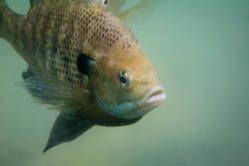The bluegill is a colorful fish that grows 4 - 10 inches long. The body is deep and highly compressed with a long, pointed pectoral fin and a distinct spot on the soft dorsal fin. The bluegill is a greenish olive color above and pale below with traces of six to eight double, vertical dark bars on its sides. The breast is yellowish white except in breeding males when it takes on a red color. The lower jaw is pale blue, and this color continues backward to the gill membranes. The gill flap is blue/black, without a pale margin. Bluegills are often mistaken for pumpkinseeds, but they lack the orange/red spot on the gill flap.
The bluegill is widespread throughout New York State. It is found in slow-moving or standing water with plenty of vegetation or other shelter such as docks and logs. Bluegills feed during the day and most actively in the morning and afternoon. Their food consists of small fish, crustaceans, insects, and plant materials.
The New York State record bluegill was caught in Kohlbach Pond in 1992. It weighed 2 lbs. 8oz. Bluegills are often caught in shallow water near weedbeds on bait, artificial flies, and lures.
Bluegills nest in colonies where their nests are so close they often merge together. They prefer to build their nests on firm sand or mud with some debris but little vegetation. The nests are 8 to 12 inches in diameter and located in water that is 1 to 3 feet deep or shallower. In New York spawning occurs from zlate May through July, when water temperatures reach the 70's F. Bluegills will start reproducing in their second year, and they have been observed to live as long as 11 years.
The bluegill has frequently been stocked in farm ponds and other impoundments. They thrive in warm, shallow farm ponds to the point where they sometimes overpopulate and their growth is stunted.
If the bass eat all of the minnows and shiners in a pond, then the bluegill may provide a continuous source of food for them. If a pond becomes overpopulated with bluegills, a more aggressive predator such as walleye may be stocked to reduce their population.
